15 Amazing Fish varieties like To Tilapia

15 Amazing Fish varieties like To Tilapia
Tilapia, renowned for its silvery-blue hue and flat-bodied charm, thrives in freshwater and brackish environments, originally hailing from Africa. While cherished as a culinary delight in the United States, tilapia shares the spotlight with other aquatic companions lining the shelves of major grocery stores across the nation, among them bass, cod, and salmon.
However, the allure of fish akin to tilapia extends beyond mere taste, encompassing shared habitats and unique parenting practices. Delve into the depths of freshwater ecosystems with these 15 captivating fish varieties that echo the essence of tilapia.
1. Atlantic Salmon
(A Culinary Delight in Harmony with Tilapia)
Dive into the aquatic world of Salmo salar, better known as Atlantic salmon, a flat fish globally acclaimed for its delectable taste. Originating from the Atlantic Ocean, this species earned the distinction of being the sole salmon native to these waters. While commercial and recreational fishing of Atlantic salmon is prohibited in the U.S., it stands shoulder to shoulder with tilapia as one of the nation’s favorite food fish.
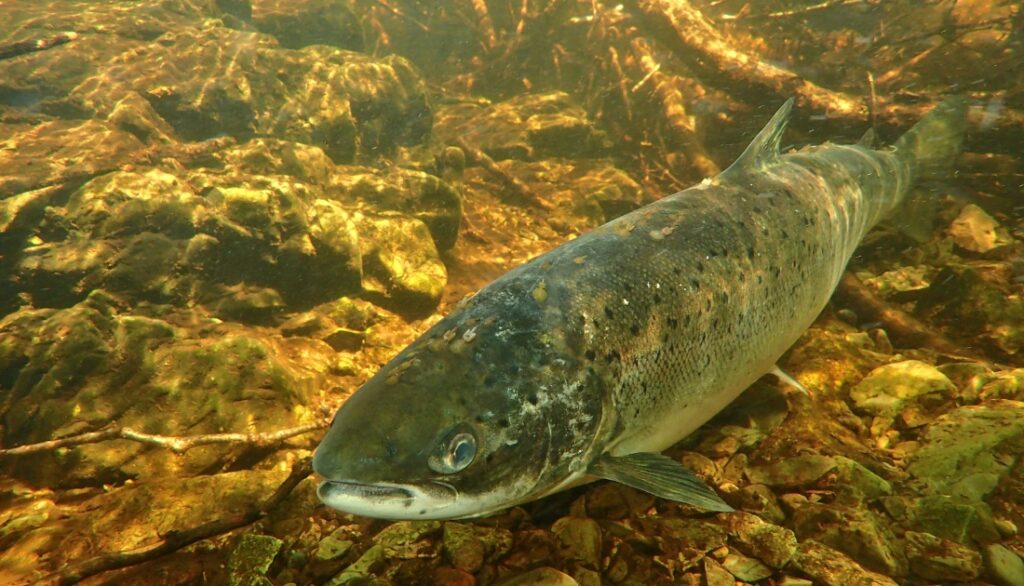
Beyond the ban, both Atlantic salmon and tilapia share the limelight for their flat bodies, though the salmon’s is elegantly elongated, adding a unique touch to their culinary appeal.
2. Atlantic Shadefish
(Echoes of Tilapia in the Depths)
Meet Argyrosomus regius, commonly known as Atlantic Shadefish, a fascinating species renowned for its striking lateral lines traversing its entire trunk. In a captivating parallel to tilapia, Shadefish boasts visible lateral lines that serve as a testament to their aquatic prowess.
Belonging to the esteemed Perciformes order of fish, Shadefish shares its lineage with tilapia, both falling under the Actinopterygii class, or “ray-finned fishes.” This remarkable classification grants them the distinct advantage of a swim bladder adjacent to their inner ear, enhancing their auditory perception underwater.
Furthermore, their robust lateral lines, a hallmark feature of ray-finned fishes, enable them to detect subtle changes in their aquatic environment, transcending the limitations of sight and smell.
3. Bluefin Tuna
(A Culinary Odyssey Similar to Tilapia)
Enter Thunnus thynnus, the illustrious Bluefin Tuna, sharing the spotlight with tilapia as two of the world’s gastronomic delights. Amidst the warm embrace of the Mediterranean Sea, this species, one of the three distinguished bluefin tunas, carves its niche. While tilapia prefers freshwater realms, the bluefin tuna thrives in the briny depths.
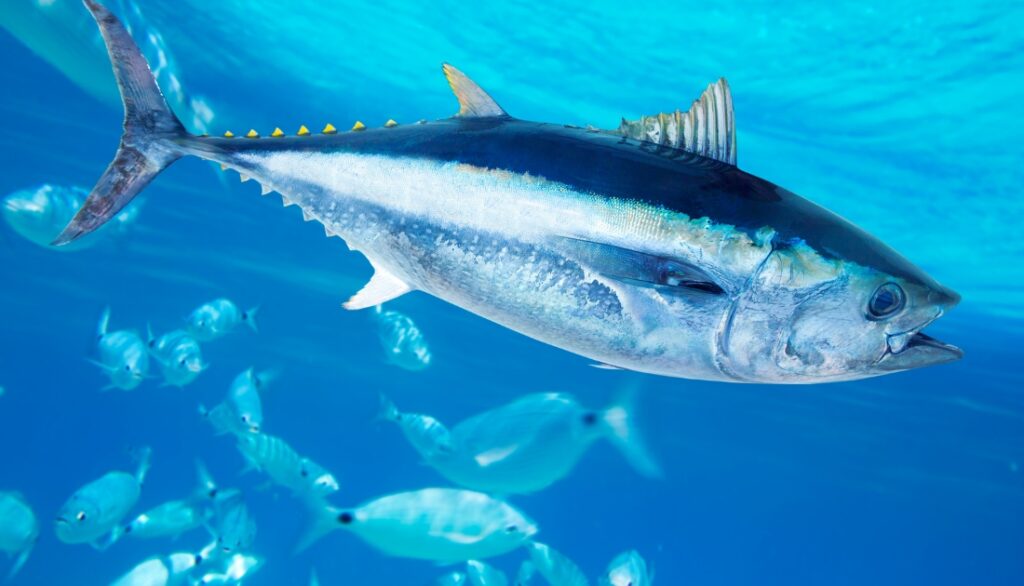
Mirroring tilapia’s global culinary acclaim, the bluefin tuna enjoys a prestigious status on dinner tables, particularly across Asia. However, beneath its gastronomic allure lies a crucial role as a key predator in its marine ecosystem. As with tilapia, the delicate balance hinges on responsible fishing practices to avert environmental repercussions.
4. Bumblebee Cichlid
(The Mouthbrooding Maestro Resonating with Tilapia)
Meet Pseudotropheus crabro, the Bumblebee Cichlid, adorned with vibrant yellow and black bars reminiscent of its namesake insect. Hailing from the freshwater realms of Africa akin to tilapia, this cichlid species shares not only a geographical origin but also a remarkable parenting strategy.
Much like tilapia and numerous other cichlids, the Bumblebee Cichlid is a mouthbrooder. Embracing the delicate art of parental care, they cradle their eggs in their mouths until the moment of hatching, ensuring the offspring’s safe and gradual foray into the aquatic world.
5. Common Sole
(Flattened Elegance in Ocean Depths)
Meet Solea solea, the Common Sole, a fish that takes the art of flatness to new depths. Even more flattened than the tilapia, this ocean dweller boasts a distinctive feature—both eyes positioned on the right side of its body. This anatomical quirk equips the sole with a strategic advantage, allowing it to seamlessly bury itself in the seabed while maintaining vigilant surveillance for both prey and potential predators.
Much like its freshwater counterpart, the tilapia, the common sole stands as a prized resource in the world of gastronomy. Its affinity for the ocean floor makes it susceptible to the skillful techniques of bottom trawlers, unveiling the delicate balance between survival in ocean depths and its role on dinner plates. Explore the oceanic elegance of the Common Sole, where flatness meets sophistication in the depths of the aquatic world.
6. Channel Catfish
(Whiskered Kin of Tilapia in American Aquaculture)
Dive into the aquatic world of Ictalurus punctatus, commonly known as the Channel Catfish, a prominent figure in the realm of U.S. aquaculture. Mirroring the culinary popularity shared with tilapia, these catfish, with their distinctive “whiskers,” navigate the freshwater domains much like their tilapia counterparts.
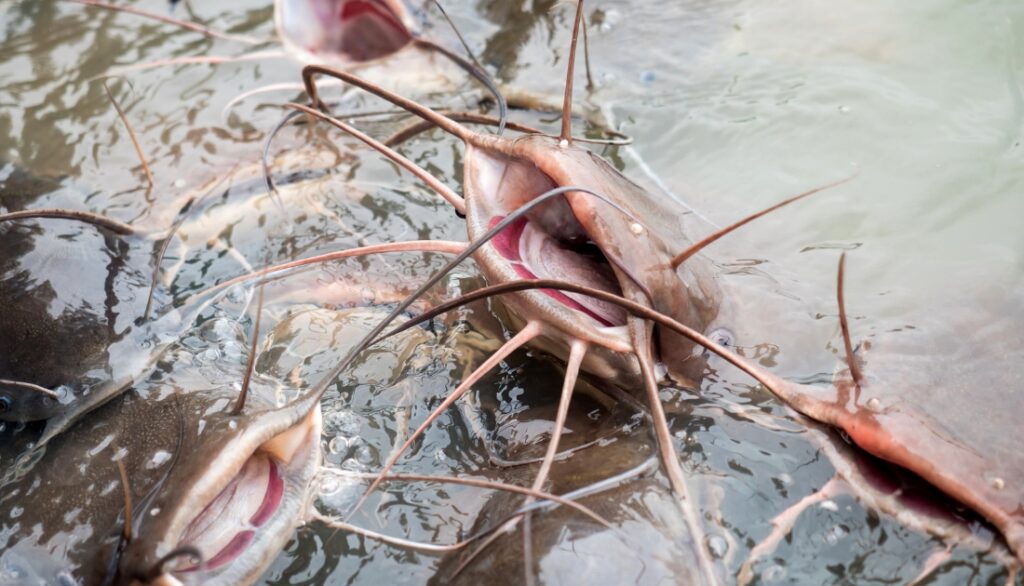
In the intricate tapestry of U.S. fisheries, both tilapia and channel catfish stand as pivotal players, contributing to the diverse tapestry of the nation’s aquacultural landscape. Explore the waters of tilapia and channel catfish, where culinary delights and whiskered wonders coexist.
7. Eastern Happy Fish
(African Kin in Freshwater Harmony)
Embark on a journey into the aquatic realms of Astatotilapia calliptera, affectionately known as the Eastern Happy Fish. Hailing from the vibrant landscapes of Africa, this freshwater dweller shares its origins with tilapia, both members of the esteemed Cichlidae family.
Dive deep into the distinctive features of this fish family, where lateral lines take a unique form, exhibiting breaks rather than a continuous line. Unveil the tale of tilapia and the Eastern Happy Fish, natives of African waters, whose introduction to North American realms adds a fascinating chapter to the aquatic narrative—whether intentional or a consequence of sport fishing or pet releases.
8. Freshwater Angelfish
(Elegance in Tropical Waters)
Delve into the aquatic elegance of Pterophyllum scalare, the Freshwater Angelfish, as it graces tropical freshwater realms much like its tilapia counterparts. Despite its smaller stature compared to tilapia, this species captivates with a unique charm, boasting a flat body and a stature that often surpasses its length.
Explore the allure of the angelfish as a prominent figure in the commercial tropical freshwater fish realm, reaching heights of about six inches. Unveil the shared preference for warm waters, connecting the narratives of angelfish and tilapias in the rhythmic flow of tropical freshwater habitats.
See Also: Seals breathing mechanism underwater
9. Mangrove Red Snapper
(A Nocturnal Symphony in Brackish Waters)
Explore the shadowy realms where Lutjanus argentimaculatus, the Mangrove Red Snapper, converges with the intriguing world of Tilapia. Known also as mangrove jack or gray snapper, these elusive creatures navigate diverse habitats, embracing the enigmatic realms of freshwater and brackish waters, echoing the adaptable spirit of tilapias.
Unveil the nocturnal ballet of these snappers, weaving through the darkness to hunt and feed under the moonlit canopy. In parallel, tilapias, too, embrace the night for feeding, their underwater activities a symphony of movement and life, creating a fascinating parallel between these denizens of the waters.
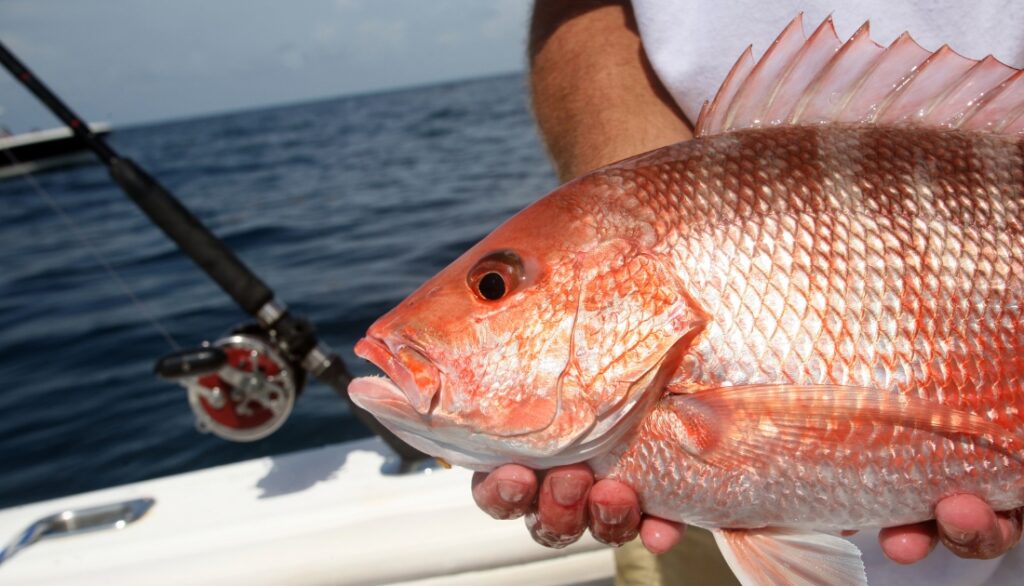
10. Malawi Eyebiter
(Echoes of Tilapia in African Waters)
Embark on an aquatic journey to discover the intriguing parallels between Tilapia and Dimidiochromis compressiceps, the Malawi Eyebiter. In the realm of African waters, these two species share common threads, uniting under the Cichlidae family.
Delve into the narrative of their dark lateral lines, weaving a semi-broken pattern along their bodies, and uncover the distinctive large, flat body structure that defines both the Malawi Eyebiter and Tilapia. As denizens of native African habitats, these fish stand as remarkable counterparts in the aquatic tapestry of the continent.
11. Nassau Grouper:
(Culinary Harmony and Conservation Concerns)
Dive into the waters of southern Florida, the Caribbean, and Bermuda to encounter Epinephelus striatus, the Nassau Grouper—an emblem of marine gastronomy akin to the beloved Tilapia. These indiscriminate feeders share a unique feeding strategy, using their protruding mouths to ambush prey, creating a captivating parallel with the tilapia’s distinct lower jaw designed for scooping in prey.
However, the tale takes a turn as conservation concerns loom over the Nassau Grouper. Explore the intricate dance between culinary appreciation and the imperative need for safeguarding these underwater treasures.
12. Pinstripe Menarambo
(A Synchrony of Cichlid Elegance)
Embark on an underwater journey exploring the elegance of Paretroplus menarambo, a cichlid companion to the renowned tilapia. Dive into the depths where their parallel worlds unfold, revealing the striking similarity in their body shapes—an almost identical dance of form and function.

Witness the dorsal fins of the pinstripe menarambo, cascading seamlessly down their trunks like an uninterrupted fan, mirroring the distinctive traits of their tilapia counterparts. Soft hues, from delicate whites to silvery blues, adorn their scales, adding a touch of aquatic artistry to these cichlid kin.
13. Pacific Sardine
(Beyond the Tin Can Chronicles)
Delve into the aquatic realm of Sardinops sagax, the Pacific Sardine, challenging the common perception of these petite fish confined to tin cans. Unveil the larger-than-life narrative of this sardine species, boasting an average length of about 14 inches, standing out among its tin-bound counterparts.
As we navigate the dimensions of size and popularity, discover the intriguing parallel with the blue spotted tilapia (Oreochromis leucostictus). While tilapias generally surpass the stature of most sardines, the blue spotted tilapia emerges as a kindred spirit, reaching up to 14 inches in a harmonious echo of the Pacific sardine’s dimensions.
14. Harmony of Flavors
(Striped Bass and Tilapia Culinary Duets)
Embark on a culinary exploration with Morone saxatilis, the Striped Bass, and tilapia, as we unravel the symphony of their mild flavors that elevate them to gastronomic stardom. The Striped Bass, a familiar resident of the east coast’s waters, gracefully navigates both ocean expanses and meandering rivers.
In the world of culinary delights, both fish claim their popularity, albeit in distinctive ways. While the invasive charm of tilapia embraces global importation from African origins, the Striped Bass proudly stands as a local favorite, with the United States fostering its fishing legacy. Join us in savoring the unique notes each species brings to the table, harmonizing diverse palates in the pursuit of deliciousness.
15. Zebra Mbuna
(A Vivid Tale of African Freshwaters)
In the aquascaping realm, Maylandia zebra, better known as Zebra Mbuna, emerges as a captivating denizen of African freshwater realms. Unlike its culinary counterparts, this vibrant species seldom graces dinner tables but finds its place of honor in the private aquarium trade.
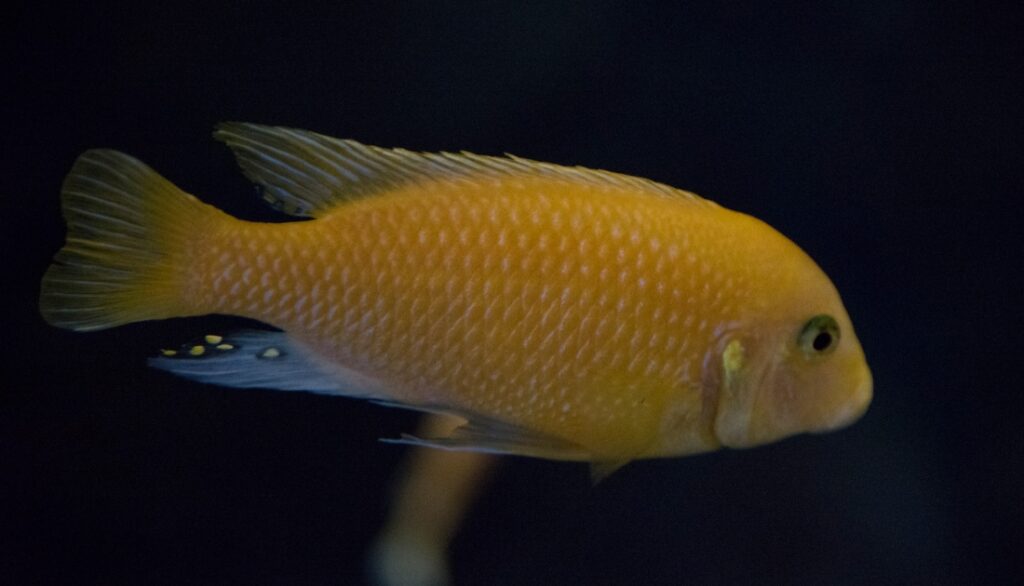
Sporting a striking blend of bluish scales adorned with vertical black bars, the Zebra Mbuna aptly earns its name from its zebra-esque allure. Originating from the rich aquatic landscapes of Africa, akin to certain tilapias, this charismatic fish shares not only the continent but also echoes the tilapia’s distinctive maternal mouthbrooding tendencies. Step into the colorful narrative of Zebra Mbuna, where aquatic aesthetics and African origins converge in a mesmerizing tale.




